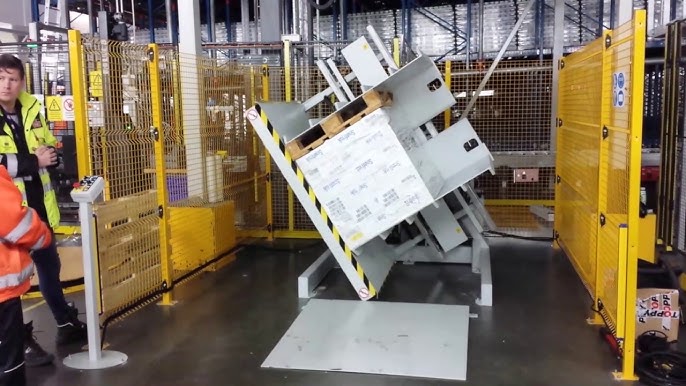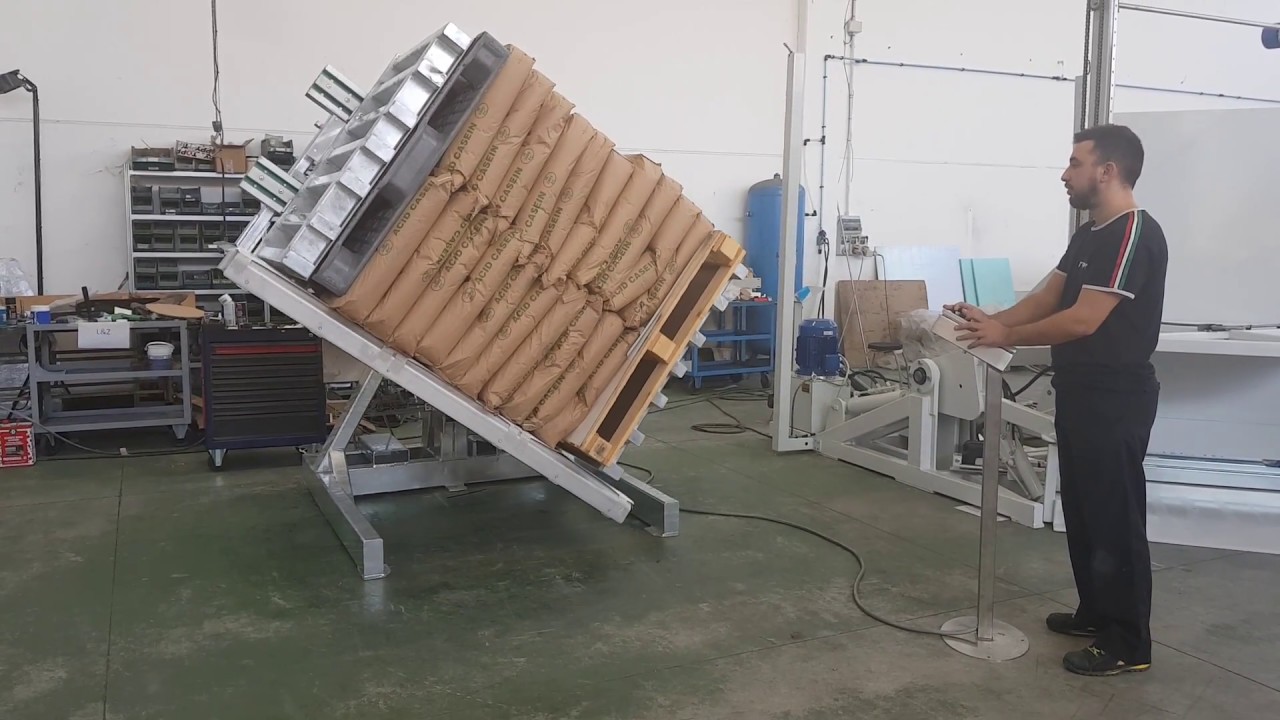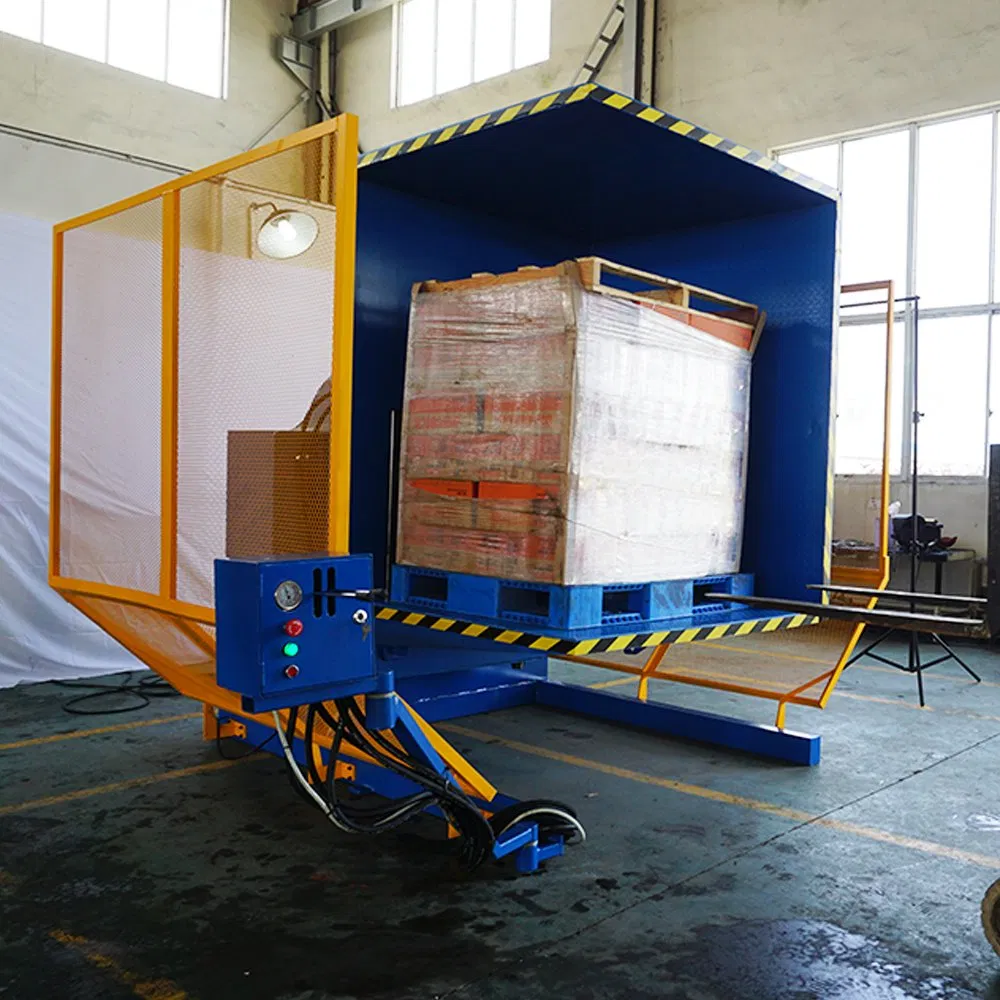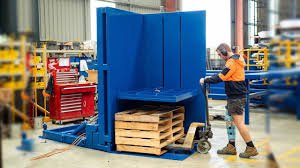Meeting Rugged Designs For Cold Storage And High Throughput Requirements in Russia with Automated Pallet Exchange
Operating a warehouse is tough. Operating one in the extreme cold of a Russian winter is a whole different level of challenge. Your equipment fails, your processes slow to a crawl, and your people are put at risk. Now, add the pressure of a high-throughput environment, like a busy steel or food processing plant, where every second of downtime costs a fortune. The standard ways of handling pallets just don't work. They are slow, inefficient, and dangerous, creating a bottleneck that can freeze your entire operation. This is a problem I've seen many times in my career, and it's a problem that demands a very specific, robust solution.
An automated pallet exchange system meets the dual challenges of Russian cold storage and high-throughput demands by being engineered from the ground up for harsh environments. This is achieved through the use of special low-temperature steel that resists becoming brittle, hydraulic systems with arctic-grade fluids and heaters, and electronics housed in sealed, heated cabinets. This rugged construction is combined with powerful automation that can handle heavy loads at high speed, seamlessly integrating into the production line to maintain throughput without manual intervention, even in temperatures as low as -30°C.

I've spent my life in the packing machine industry, from my early days on the factory floor to building my own company, SHJLPACK. I’ve learned that the right machine isn't just about the specs on a data sheet. It's about understanding the real-world environment it will live in. A machine that works perfectly in a temperate warehouse in Spain might fail spectacularly in a Russian winter. It’s not just about buying a machine; it’s about investing in a solution that understands your unique challenges. Let's break down exactly how these specialized systems are designed to not just survive, but thrive in these demanding conditions.
How does an automated pallet exchange system handle extreme cold in Russian warehouses?
Imagine your standard hydraulic fluid in sub-zero temperatures. It turns to sludge. Metal that is strong at room temperature can become as brittle as glass. Electronic sensors give false readings or just stop working. This is the reality for businesses operating in the extreme cold of places like Siberia. They are fighting a constant battle with physics. Every breakdown means a halt in the supply chain, costly emergency repairs, and the risk of missing critical shipping deadlines. The agitation is constant, as managers worry if today is the day their logistics will grind to a frozen halt. The solution is not to simply place a standard machine in a cold room and hope for the best. The solution is to use a machine specifically engineered for the arctic.
An automated pallet exchanger handles extreme cold by incorporating materials and components designed for sub-zero performance. This includes using specialized low-temperature steel alloys for the frame and critical parts to prevent brittle fracture. The hydraulic system is filled with arctic-grade oil that maintains its low viscosity, and it's often equipped with oil tank heaters to ensure smooth operation on startup. All electronic components, like the PLC and VFDs, are housed within NEMA-rated, sealed, and heated control cabinets to maintain a stable operating temperature and prevent condensation, which is a silent killer of electronics.

The Science Behind Cold-Weather Reliability
Let’s go deeper into the engineering. The choice of steel is perhaps the most critical factor. Standard carbon steel undergoes a "ductile-to-brittle transition" at low temperatures. This means a part that would normally bend under stress will instead shatter without warning. I remember a client in Novosibirsk who bought a machine from a supplier who didn't understand this. The main support arm cracked in the middle of winter, dropping a two-ton load. It was a disaster. For our cold-storage projects, we use specific steel alloys that have been Charpy impact tested at low temperatures to guarantee their ductility and strength. It costs more, but it’s the only way to ensure safety and reliability.
Keeping the Machine's Brain and Muscles Warm
The electronics and hydraulics are the brain and muscles of the machine. If they fail, the machine is useless.
- Electronics: A heated control cabinet is non-negotiable. We create a small, stable "micro-climate" inside the panel. This prevents the delicate processors and drives from freezing. But it also fights a more subtle enemy: condensation. When a machine cycles or the warehouse doors open, temperature changes can cause moisture to form on cold surfaces. This moisture can short-circuit a circuit board instantly. A sealed, heated cabinet keeps the interior components above the dew point, keeping them dry and functional.
- Hydraulics: The problem with hydraulic oil is viscosity. As it gets colder, it gets thicker, like honey. A standard pump will struggle to move this thick fluid, leading to slow, jerky movements or even pump failure. We use synthetic, arctic-grade hydraulic fluids with a very low pour point. We also often install small heaters in the hydraulic reservoir. This ensures the fluid is at an optimal viscosity before the first cycle of the day even begins, ensuring smooth and powerful performance from the moment you press "start."
| Component | Standard Design | Cold Storage Design | Why it Matters |
|---|---|---|---|
| Frame Steel | Standard Carbon Steel (e.g., A36) | Low-Temp Alloy Steel (e.g., A516) | Prevents brittle fracture and catastrophic failure in sub-zero temperatures. |
| Hydraulic Fluid | ISO 46 Standard Oil | Synthetic Arctic-Grade Oil | Maintains low viscosity for smooth, powerful hydraulic function. |
| Control Cabinet | Vented, Unheated | NEMA 4/IP66 Sealed, Heated | Protects electronics from freezing and condensation, preventing short circuits. |
| Cabling | Standard PVC Insulation | Low-Temp Polyurethane/TPE | Prevents cables from becoming stiff and cracking during movement. |
| Sensors | Standard Inductive/Photoelectric | Low-Temperature Rated (-40°C) | Ensures accurate and reliable detection for safe automated sequences. |
What makes a pallet exchanger design 'rugged' enough for high-throughput steel operations?
The environment in a steel mill or a high-volume distribution center is unforgiving. It’s not just about heavy loads. It's about the relentless pace, the constant vibration, and the abrasive dust that gets into everything. A machine built for a quiet, clean warehouse will be shaken to pieces. I’ve seen it happen. A business invests in automation, but the machine they buy is built with a light-duty frame and standard components. It looks good on day one, but after a month of 24/7 operation, the bearings are shot, the frame is flexing, and the machine is a constant source of maintenance headaches. This failure turns a potential solution into a production bottleneck, costing the company far more in downtime than they ever saved on the initial purchase. A truly rugged design isn't just about using thicker steel; it's about a philosophy of over-engineering for survival.
A pallet exchanger is made 'rugged' for high-throughput operations through a combination of a massively overbuilt frame, oversized power components, and a design that minimizes wear and tear. The frame is typically constructed from thick, fully welded steel plates with added reinforcements at key stress points, analyzed with Finite Element Analysis (FEA) to eliminate any flexing under maximum load. Motors, gearboxes, and hydraulic cylinders are intentionally oversized, so they operate at only 50-60% of their maximum capacity. This drastically reduces strain and extends their service life. Finally, surfaces that contact pallets are made from wear-resistant materials like hardened steel, and sensitive components are shielded to protect them from the harsh industrial environment.

The Foundation of Strength: Frame and Structure
When I started as an engineer, one of my mentors told me, "The frame is the machine's skeleton. If the skeleton is weak, the whole body will fail." That has stuck with me. For heavy-duty applications, a bolted frame is simply not an option. Over time, vibrations will work the bolts loose, and the entire structure will lose its rigidity. A rugged design demands a fully welded, stress-relieved structural steel frame. We use FEA software to simulate the forces of a two-ton pallet being clamped and rotated hundreds of times an hour. This analysis shows us exactly where the stress is concentrated, and we add gussets and reinforcing plates to those areas. It’s the difference between a machine that lasts five years and one that lasts twenty.
Power Without the Strain
Think about a small car engine trying to pull a heavy truck. It might do it for a little while, but it will be running at its redline, and it won't last long. It’s the same with industrial machinery. A common cost-cutting measure is to use motors and hydraulic pumps that are just barely adequate for the job. They can lift the load, but they are working at 95% of their capacity on every single cycle. This generates excess heat, causes premature wear, and leads to early failure. Our philosophy for rugged design is to oversize these core components. If the load requires a 5 kW motor, we use a 7.5 kW motor. If it needs a 10-gallon-per-minute pump, we use a 15 GPM pump. The components run cooler, quieter, and with far less strain. This small increase in upfront cost pays for itself tenfold by avoiding unplanned downtime.
| Feature | Standard Design | Rugged, High-Throughput Design | The Advantage |
|---|---|---|---|
| Frame Construction | Bolted, thin-gauge steel | Fully welded, thick-plate, reinforced | Resists vibration and flexing, ensuring long-term structural integrity. |
| Component Sizing | Sized to exact load requirements | Oversized by 30-50% | Runs cooler and under less stress, dramatically increasing lifespan. |
| Wear Surfaces | Standard painted steel | Hardened steel or UHMW liners | Resists abrasion from pallets, preventing wear that leads tosloppy operation. |
| Bearings | Standard sealed bearings | Heavy-duty, self-aligning, sealed | Accommodates slight misalignments and is better protected from dust and debris. |
| Maintenance Access | May be an afterthought | Designed with large access panels | Simplifies inspection and preventative maintenance, reducing service time. |
How can automation in pallet exchange reduce operational costs and improve safety?
Look at any manual pallet handling process. You see people lifting, bending, and twisting, often in a hurry. You see forklifts maneuvering in tight spaces. This is a recipe for two things: high costs and high risks. The costs come from labor. You are paying multiple people, often across multiple shifts, to do a repetitive, low-value task. And every minute they spend manually re-stacking a load is a minute your product isn't moving toward the shipping dock. The risk is even more serious. Back injuries from lifting are one of the most common and expensive workplace injuries. An accident with a forklift can be catastrophic. These direct and indirect costs eat away at your profit margins every single day. The solution is simple: take the person out of the hazardous process entirely.
Automation in pallet exchange provides a powerful, two-pronged benefit: it dramatically cuts operational costs while simultaneously creating a much safer work environment. Costs are reduced by reassigning manual laborers to more valuable tasks, increasing the speed and throughput of the pallet transfer process, and virtually eliminating product damage that occurs from manual handling. Safety is fundamentally improved by removing employees from the zone of lifting and moving heavy loads. This eliminates the risk of ergonomic injuries and creates a controlled, predictable process protected by modern safety hardware like light curtains and physical guarding.

The Tangible ROI of Automation
As a business owner, I look at every investment through the lens of Return on Investment (ROI). This is where automation really shines. Let's break it down with simple numbers. Imagine a manual process requiring two workers per shift, on a three-shift operation, to transfer pallets. That's six employees. An automated pallet exchanger, integrated with conveyors, requires zero direct operators. The labor savings alone can be massive. But it goes further. A manual team might be able to transfer 10-15 pallets per hour, with breaks and fatigue. An automated system can consistently do 40, 50, or even 60 pallets per hour, every hour, without stopping. This increase in throughput means you can ship more products with the same facility footprint. Finally, consider product damage. Manual handling, especially with unstable loads, can lead to dropped or damaged goods. Automation is gentle and precise, reducing these damage-related costs to near zero.
Designing a Safer Process
From my first days as an engineer, safety has been paramount. Helping my clients grow their business is my goal, but ensuring their people go home safe every day is my responsibility. An automated pallet exchanger is a fortress of safety. The entire operating area is typically enclosed by a safety fence. Access gates are interlocked, meaning the machine will immediately stop if a gate is opened. The entry and exit points are protected by light curtains. These are beams of infrared light that, if broken by a person or object, trigger an emergency stop before any harm can be done. This layered approach creates a system where it is virtually impossible for a worker to be in a dangerous position while the machine is active. It's a huge step up from the uncontrolled environment of forklifts and manual labor, and it helps our clients meet and exceed stringent government safety regulations.
| Cost/Safety Factor | Manual Pallet Exchange | Automated Pallet Exchange | Annual Impact (Example) |
|---|---|---|---|
| Direct Labor | 2 workers/shift x 3 shifts | 0 operators (supervisor only) | Savings of ~$200,000+ |
| Throughput | ~15 pallets/hour | ~50 pallets/hour | 3x+ increase in line capacity |
| Product Damage | ~1-2% of handled goods | <0.1% of handled goods | Savings of ~$25,000+ |
| Ergonomic Injury Risk | High (lifting, twisting) | Eliminated | Reduced insurance premiums and liability. |
| Forklift Traffic | High in transfer area | Reduced/Eliminated in transfer area | Lower risk of collisions and accidents. |
What are the key considerations when integrating a new pallet exchange system into an existing production line?
Buying a powerful, well-built machine is the first step. But the success of the project hinges on the second step: integration. I’ve seen companies spend a lot of money on a top-of-the-line machine, only to have it sit like an island in their factory, creating a new bottleneck. The forklift has to drive a long, awkward path to reach it. The output conveyor is at the wrong height. It can't communicate with their factory management software. This is a failure of planning. A poorly planned integration can cause weeks of unexpected downtime during installation and result in a system that never performs at its peak. The machine becomes a source of frustration instead of a source of efficiency. A strategic partner doesn't just sell you a machine. They help you weave it seamlessly into the fabric of your operation.
The key considerations when integrating a new pallet exchange system are spatial, mechanical, and digital. First, you must analyze the physical layout and product flow to determine the optimal machine placement that minimizes forklift travel and fits with existing conveyors. Second, you must ensure mechanical compatibility, including infeed/outfeed heights, pallet orientation, and load stability. Finally, and crucially for modern factories, you must plan the digital integration, defining how the pallet exchanger's control system will "handshake" with your higher-level Warehouse Management System (WMS) or MES to exchange data and commands, creating a truly automated process.

Beyond the Footprint: Planning for Flow
The first question is always "Where will it fit?" But the better question is "Where will it create the best flow?" I always start projects like this by modeling the client's current workflow. We use 2D and 3D layout software to map out the paths of forklifts and products. Then, we place a virtual model of the new pallet exchanger into that layout. This allows us to experiment. What if we place it here? How does that affect the distance the forklift needs to travel? What if we rotate it 90 degrees? Does that create a better interface with the main conveyor line? I once worked with a client where this process revealed a major bottleneck in their existing layout that had nothing to do with the new machine. By re-routing one conveyor line as part of the installation, we not only integrated the new pallet exchanger but also increased their overall line efficiency by 15%.
The Digital Handshake for Smart Factories
For a forward-thinking owner like Javier Morales, this is critical. A modern machine cannot be a "dumb" island of automation. It must be a citizen of the digital factory. This means planning the communication between the pallet exchanger's PLC (its brain) and the factory's MES or WMS (the central command). We have to ask the right questions early on. What information does the MES need? Does it need a simple "cycle complete" signal, or does it need detailed fault codes, cycle times, and the weight of the load? What protocol will they use to talk? Profinet? Ethernet/IP? This digital handshake allows for true, unattended automation. The MES can send a command to the machine to begin a cycle, and the machine can report back its status, all without human intervention. This is the foundation of Industry 4.0 and a fully visualized production process.
| Integration Phase | Key Consideration | Action Item | The Goal |
|---|---|---|---|
| 1. Discovery & Layout | Physical space and product flow. | Conduct a site survey. Create a 3D layout simulation. | Optimize machine placement for efficiency and safety. |
| 2. Mechanical Interface | Conveyor heights, pallet types, load stability. | Confirm technical drawings. Test with sample pallets/loads if needed. | Ensure a seamless physical transfer of goods. |
| 3. Electrical & Control | Power requirements and control system communication. | Define the PLC "handshake" protocol with the MES/WMS. | Create a fully integrated and automated data exchange. |
| 4. Installation & Safety | Minimizing downtime and ensuring safety compliance. | Develop a phased installation plan. Install and commission safety systems (fencing, light curtains). | A fast, safe installation that doesn't halt production. |
| 5. Training & Handoff | Operator and maintenance team readiness. | Conduct comprehensive, hands-on training for both operators and technicians. | Empower the client's team to own and maintain the system. |
Conclusion
A rugged, automated pallet exchanger is more than a machine. It's a strategic asset that conquers harsh environments, cuts costs, and drives your operation's efficiency and safety forward.




